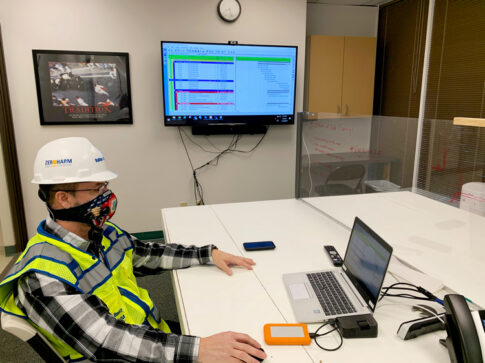
The Tech-Empowered Superintendent
With nearly four decades of industry experience, Balfour Beatty Superintendent Kyle Kragseth thought he was prepared for any challenge or circumstance a construction project could present. That was until March, when COVID-19 led to a temporary shutdown of his project, a 289,000-square-foot interiors upfit for a leading high-tech client.
Cognizant that jobsite operations would not return to normal even once they were able to restart the project, the team rapidly identified and implemented new technologies that would help sustain its pre-COVID progress on an expedited schedule. Like many other industries undergoing a digital transformation, the team quickly observed the power of technology to revolutionize day-to-day roles. Arguably, the field superintendent saw the most impact to the evolution.
Kragseth’s own father, a 78-year-old superintendent who still doesn’t own a computer, prefers walking jobsites with pen, paper and clipboard in hand. And he’s not alone. Many of the industry’s most experienced superintendents who came up through the ranks as carpenters or forepersons can approach new technologies with initial skepticism regarding their value.
Today, Kragseth is a firm believer in Lean practices like the Last Planner System that utilize technologies including Touchplan and Bluebeam. These technologies enable live digital planning and empower the team to become more productive, agile and safe, while navigating the challenges of COVID-19. Although Kragseth still has a few blueprints and look-ahead schedules scattered around his desk, you won’t see him reverting to former ways of working in the future.
“The pace of today’s projects doesn’t allow us to travel halfway across the city for meetings. It’s unsustainable,” remarks Kragseth, who identifies his work style as a hybrid between the profession’s traditional past and innovative future.
That pace is also unsustainable for an industry contending with a serious skilled labor shortage. Statistics from the Current Population Survey suggest that today’s shortage will become the next decade’s crisis. In 2019, the median age of first-line supervisors of construction trades and extraction workers was 45 years. As contractors build resilience into operations, they must focus on what has widely been described as the “vanishing superintendent” role.
Although a confluence of factors has contributed to the industry’s shrinking labor pool, many aspiring construction professionals have gravitated toward office-based project management roles—in part due to a lack of awareness about the sophisticated management, communication and leadership skills a superintendent must possess in today’s marketplace. Increasingly, that skillset is expanding to include a superior command of leading-edge technologies, making the position more attractive to younger generations that grew up in the digital age and are more likely to enter the industry with construction management or related college degrees.
Nineteen-year industry veteran Strider Ellison, who is working with Kragseth on the same tenant improvement project as an assistant superintendent, has witnessed technology serve as a great equalizer during COVID-19 for every project stakeholder while eliminating waste.
Where a superintendent was once handed a schedule and instructed to manage it, technologies like Touchplan and Bluebeam can facilitate the collaborative co-creation of the project plan. Rather than spending time soliciting information from siloed trades, sorting through post-it notes, updating the plan across multiple platforms and then communicating upstream, superintendents can focus on adding value by addressing the team’s needs and high-level oversight and execution of the plan.
Cloud-based platforms also foster a more inclusive planning process for trade partners. By providing comprehensive, real-time and location-independent access to the big-picture plan, these tools allow trades to better understand their commitments and identify constraints together.
“Everyone has an equal voice and a stake in the plan,” praises Ellison. “In turn, that fundamentally changes the role of the superintendent in a way that enhances job performance and satisfaction.”
A critical element in solving the labor shortage is ensuring forepersons receive adequate learning and development opportunities to prepare for the superintendent role. On projects where the Last Planner System and supportive planning technologies have been implemented, forepersons are receiving critical training and experience much earlier in their careers.
With this tech-driven evolution, superintendents of the future will effectively balance “hard skills” or technical competencies with “soft skills” like curiosity, adaptability and communication to create progressive jobsite cultures that invest in both people and innovation.
“Whatever we’re doing today, it could be different in a year. You have to continually be a student, willing to explore new ideas and technologies,” affirms Ellison.
COVID-19 exposed the importance of a strong technology platform to business resilience and longevity. For the construction industry, it has further empowered the superintendent as a leader and motivator who drives collaboration and team integration, inspiring a new generation to build rewarding careers in the field.
About the Author – Erin L. Branham is National Director, Brand and Communications for Balfour Beatty. The company has three offices in the Carolinas — Charlotte, Raleigh and Charleston. For more information, visit www.balfourbeattyus.com.
This article originally appeared in Construction Superintendent magazine. Reprinted with permission.






